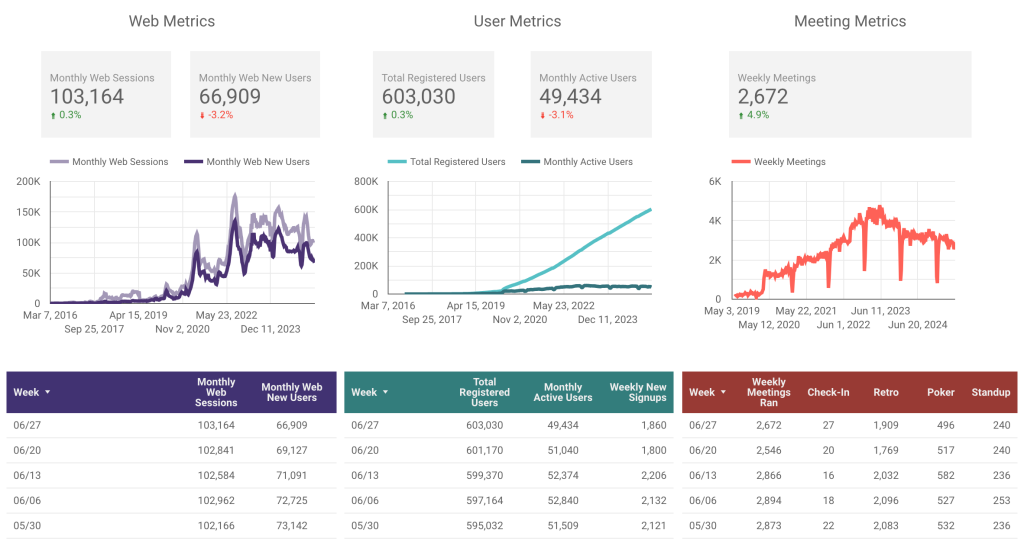#449 – Rethinking Team Health in 2025
Friday Ship #449 | June 27th, 2025

This week I spent time pondering what a great team health tool looks like in 2025. How are work dynamics shifting, or in some cases settling, after Covid? What concerns teams, managers, and leaders the most?
The friction of modern collaboration hasn’t gone away. Misalignment happens. Tension simmers. People burn out. Employees want transparency, agency, and a sense that feedback leads somewhere. Managers want early insight and the ability to be effective. At a high level leadership wants to see where to lean in and where to get out of the way.
Team health needs better tools and better habits. Here are a few ideas we’re exploring.
1. Build the values together
Templates are helpful, especially ones based on trusted models like the Spotify Squad Health Check, Atlassian’s Team Health Monitor, or Google’s research on psychological safety. But no set of pre-written questions is perfect for every team.
We’re designing a way for teams to shape their own health check-ins: brainstorm what matters, rank shared values, and turn those into the questions they track. The goal is to get input and buy-in from the start.
In Parabol, folks can start with a template and adapt it over time. Or they can build their process from scratch, even running a collaborative activity to do so.
2. Support deeper conversation early and often
The value of a health check isn’t in the data. It’s in adapting in real time.
We believe team health questions should unlock conversation as needed, just in time. We like the idea that folks can add comments, not just scores, to add context and detail. These comments can raise the fidelity of the conversation, allowing for deeper discussion and building trust.
In Parabol facilitators should be able to add a prompt to the retro or an agenda item to the team check-in based on what they’re sensing. And when something needs attention, takeaways can be created immediately.
This is good for managers. Instead of sifting through survey data after the fact and wondering what to do, they can invite the team to reflect while it’s top of mind. Together, the team can shape their next steps.
3. Make data transparent and useful
We’re exploring the idea that when a team owns the data, it’s more likely to act. Not everything needs to flow through the manager. If a trend emerges, the software could prompt the team to run a specific check-in, fun team-building game, or a retro focused on team dynamics without extra planning.
That kind of ownership raises questions. Will the team pay attention to the trends? Will they know how to respond? Will the manager feel supported by this transparency, or exposed?
For managers, the opportunity goes beyond dealing with conversations one at a time in meetings. If they can suggest changes within a meeting and later see those actions reflected in positive team health trends, they gain a feedback loop. They can learn what worked, capture that knowledge, and even share it with other teams. AI can be leveraged, providing further insights from these data over time.
Leadership needs a different lens. What patterns are emerging across teams? Are there signs of improving trust, clarity, or sustainable pace? What signals point to engagement or risk? If managers can report back in meaningful ways at the right level of zoom, leaders can better understand where to lean in, and where to support without micromanaging.
Where we go from here
The bar for team health tooling has changed. In a workplace shaped by remote norms, AI tooling, and shifting expectations, check-ins can’t just be about measurement. Employees expect timely adaptation and real change within days and weeks, not months and quarters.
At the same time, managers and leaders need visibility that helps them act sooner. They need to understand the moments where a team is stuck, uncertain, or thriving. Tools that help teams talk about their working dynamic don’t just reduce friction. They can normalize these learnings as knowledge that supports the organization in reaching its goals.
That’s where we’re focusing our efforts. We’re helping teams build stronger dynamics, better relationships, and more meaningful work. And we’re helping leaders and managers align with their teams, support them effectively, and reach their goals.
Metrics

We’re seeing a positive trend for web sessions. However, we sense a summer slow-down in terms of active users. At any rate, we’re looking to expand out of agile ceremonies into all kinds of collaborative activities in order to engage and serve more teams in more companies, not just engineering teams in software companies. Stay tuned to our plans for each cycle.
This week we…
…kicked off Product Cycle 9. This cycle we’re focused on:
- Getting the pages and insights features into the hands of all users
- Improving task due date notifications
- Developing our architecture for a Zoom Transcription feature
- Shaping team health UX as a first activity in our new, modular meeting framework
…set up demos and meetings. We’ve been busy getting in touch with our customers and partners to take next steps on better packaging our software and aligning new product development to match their needs.
…pushed forward on our sales motion. We’ve been tracking a number of improvements to how we are approaching our sales activities and seeing good results in customer engagement and helping accounts be on the right plan.
Next week we’ll…
…finalize company strategy for T2. The leadership team will propose a strategy for the trimester. We also plan to meet with the board.
Have feedback? See something that you like or something you think could be better? Please write to us.
